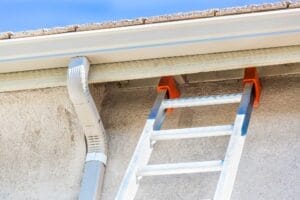Are you having trouble with the drip, drip, drip coming in through your roof? Have you noticed a shingle or two blow away during a storm? Maybe you have wondered about your roof because of its age. These and other situations can cause homeowners to wonder what to do about their roof. Should they repair it or replace it?

Often you can repair a roof with minor problems, and this is the practical route to take. Other times, the roof needs a complete overhaul. It’s important to make the right choice when dealing with your roof problems. On the one hand, you don’t want to overlook a serious problem and do a quick repair, and on the other hand, you don’t want to invest the money for a whole new roof if you only need a repair.
So, how can you be sure you’re making the right decision? This guide will let you know when a roof replacement is necessary.
When you Should Replace Your Roof
Weather-Related Disaster
Wind, rain, hail, and lightning can really wreak havoc on your home. When storms hit an area, they often leave a trail of destruction in their path. From downed trees to blown shingles, storms have mighty power to do a lot of damage. If a weather-related disaster hit your roof, it may be time for a new one. When heavy winds or lightning rip through the area, shingles aren’t the only thing that takes a hit. Sometimes a large tree branch falls unto the roof, causing more damage than expected. At this point, it’s wiser to go ahead and get a new roof because of the severity of the situation. In fact, your insurance company may cover the damages.
Fire
Over one million fires occur in the United States each year. Fires can have devastating effects on homes. Sometimes the fire is contained to just one small area before it’s put out, but other times the fire is more widespread. If a fire spreads to the ceiling and roof, then the heat will cause extensive damage. When this happens, a new roof is in order.
Evidence of Water Damage
You know you need to replace your roof if you begin to notice the telltale signs of water damage on the ceiling. Spotting water damage on the ceiling is easy. Look for spots and stains that are “a yellow, brown, or copper color.” The ceiling paint may start to peel, crack, and fall on the floor, as well. Water not only rots the wood and paint, but it also causes mold to develop. Water that has permeated beyond the roof to the ceiling and is leaving a mark is indicative of water that’s been there a while. The likelihood of mold is evident. Mold is harmful to your health. It can aggravate asthma and other breathing and lung conditions. A simple shingle fix won’t solve the problem in this case.
Multiple Factors Combined
Sometimes it’s a combination of factors that point to needing a new roof. Over time, shingles come loose, blow off, and become missing. When it’s only a few, it’s not too bad. However, when you have multiple shingles missing, the repair costs could begin to creep closer to the cost of a new roof. If your roof is old (20 years or more) and you plan on staying in your house for many more years, then it makes more sense to get a new roof.
When roof problems strike, take time to assess the situation. Determine whether a new roof is necessary or if you can get by with a repair. Make the best decision by weighing all the factors. For more help and information, contact Fitz Roofing today.





